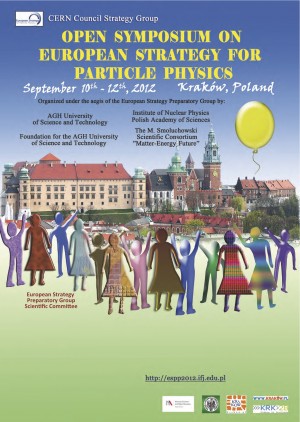This February, the CERN Council initiated the process to review the implementation of the 2006 European Strategy for particle physics. For that purpose a specific European Strategy Group was created with the aim of establishing a proposal for an update of the medium- and long-term European Strategy for Particle Physics. Tatsuya Nakada chaired this group. This proposal will eventually be submitted for approval to the CERN Council. Details of the process, members, mandate and timeline can be found on the group’s webpage.
On 31 July the period for accepting submissions on scientific issues was closed. All the collected materials will be discussed in an Open Symposium in Kraków in Poland from 10 to 12 September. The whole update process will include several steps until May/June 2013 when the new European Strategy will be adopted in a special session of the CERN Council in Brussels. It is also expected that the update of the Strategy will become an agenda item for the European Union Council of Ministers meeting to be held at the same time.
The linear collider community has submitted several documents analysing the physics case, the project’s technological status and its maturity for the International Linear Collider (ILC) as well as for the Compact Linear Collider study (CLIC). These documents can be seen online for ILC and CLIC.
The ILC submission to the European Strategy Process consists of seven documents. The first one is the cover letter, which shows the general characteristics of the ILC, including the description of the accelerator, the detectors and the physics. This part places the ILC within a strategic overview of the field of particle physics over the next two decades, including possible upgrades and special running modes. The second document is a summary of the accelerator Technical Design Report. The following document is taken from the ILC Project Implementation Planning document and discusses the governance of the ILC project, its implementation, project management and schedule. The fourth document includes the physics case for a linear collider including the latest results from the LHC and the recent discovery of the Higgs-like particle. A committee chaired by Francois Le Diberder and composed of Jim Brau, Rohini Godbole, Mark Thomson, Harry Weerts, Georg Weiglein, James D. Wells and Hitoshi Yamamoto has compiled this physics case. The document constitutes a common submission from the linear collider community and it is endorsed by both the ILC and CLIC as it argues the physics case for a linear collider independent of the technology. The fifth and sixth documents set out the status, plans and prospects for the ILD and SiD detector concepts. Finally the seventh document summarises the spin-offs resulting from the detector R&D work.
These documents being presented to the European Strategy are the result of a tremendous common effort of the worldwide ILC community throughout many years to which the Europeans have contributed, but which they could never have achieved alone. This fact, while it may be obvious, should be recognised and credited. For instance, the physics case document uses many arguments and results developed in the Physics at the International Linear Collider report, which will be part of the ILC Detailed Baseline Design report that has been produced by Howard Baer et al. and coordinated by Michael Peskin.
Now that the die has been cast (alea iacta est), our project will be discussed by the broad particle physics community and it is our challenge to convince the rest of this community of the critical added physics value of the ILC. In connection to this general objective, finding the proper balance to make the task compatible with the LHC upgrade programme will be a major step forward, mainly but not only for Europeans. The whole ILC community should feel engaged in this discussion because its results surely will also have implications extending outside Europe.



Recent Comments